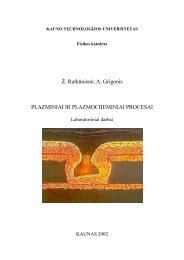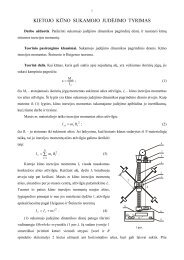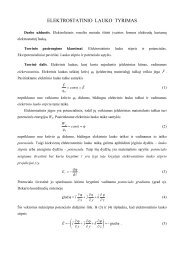PROCEEDINGS OF THE 7 INTERNATIONAL ... - Fizika
PROCEEDINGS OF THE 7 INTERNATIONAL ... - Fizika
PROCEEDINGS OF THE 7 INTERNATIONAL ... - Fizika
Create successful ePaper yourself
Turn your PDF publications into a flip-book with our unique Google optimized e-Paper software.
G. Adlys / Medical Physics in the Baltic States 7 (2009) 86 - 90<br />
100 keV in the beam would be 90 %, the neutron flux<br />
on the collimator output - approximately 1x10 9 cm -2 s -1 .<br />
The dose produced by an accompanying gamma<br />
radiation could reach 50 % - level of the total dose [2].<br />
6. The neutron sources for therapy<br />
In clinical practice, basically powerful cyclotrons or<br />
nuclear reactors are used as neutron sources. Wide<br />
utilization of such facilities is limited by high<br />
construction and maintenance expenses and nuclear<br />
safety reasons.<br />
The initial clinical studies in boron neutron capture<br />
therapy were carried out with fission reactor produced<br />
neutron beam of thermal neutrons [9].<br />
The nuclear reactor is the most powerful stationary<br />
source of neutrons. At 1 MW heat power in the reactor<br />
core, approximately 10 17 neutrons s -1 are produced. It is<br />
quite natural that the beams of the reactor neutrons have<br />
been used for the NCT and FNT purposes.,There are<br />
still some active operating therapeutical beams<br />
produced in nuclear reactors of various kinds and<br />
powers in the world.<br />
Another approach to using fission reactors has been<br />
based upon the use of a fission converter which converts<br />
a reactor’s thermal neutron to fission neutron beams.<br />
This approach could be especially useful for the<br />
adaptation of the existing medium power multipurpose<br />
reactors for neutron capture therapy.<br />
Modification of existing reactors, new reactors designed<br />
specially for BNCT and accelerator based sources<br />
would all have to be considered to meet the increased<br />
need for neutron therapy.<br />
The MTR reactor designed for medical research has a<br />
power of 10 MW. Some other reactors developed as<br />
sources of neutrons for NCT have a power ranging from<br />
5 to 20 MW.<br />
A BNTC treatment facility is in use at the VTT<br />
Chemical Technology’s FiR-1 research reactor facility<br />
(250 kW Triga reactor) in Espoo, Finland [10]. The<br />
neutron beam from the reactor is moderated into the<br />
epithermal (0.5-10 keV) energy range in the<br />
aluminiumfluoride-aluminium layers.<br />
Despite the nuclear reactor in its stationary regime of<br />
operation has a constant power level and the beam<br />
composition thereby providing standard expositions, a<br />
powerful reactor is a very complex and expensive<br />
facility whose maintenance demands quite strong<br />
requirements for nuclear safety. With quite a rare<br />
exception, the cancer therapy centers and clinics are<br />
usually remote from the physics centers having nuclear<br />
reactors.<br />
The development of accelerator based neutron sources<br />
(ABNS) has been of interest for almost three decades<br />
[11]. The main goal of all the investigations was and is<br />
to create ABNS that will produce epithermal beams<br />
with a sufficient flux of neutrons and energy spectrum<br />
as those produced by nuclear reactors.and to secure<br />
more clinically friendly environment for the treatment<br />
of patients than the environment at a nuclear reactor<br />
facility is.<br />
89<br />
Nuclear reactions on light nuclei are supposed to be<br />
used for the production of neutrons. In some clinics<br />
neutron generators based on T(d,n) 4 He fast neutron<br />
sources are used [12]. However wide use of neutron<br />
generators is limited due to a strong regulation on highactivity<br />
tritium target application.<br />
Experimental results specifying neutron yield data from<br />
thick target on accelerator-based neutron source show<br />
that the most prospective reactions considerd for the fast<br />
neutron therapy are: 7 Li(p,n) 7 Be, 7 Li(d,n)2 4 He and<br />
9 Be(d,n) 10 B.<br />
Protons or deuterons with energies up to 2-2.5 MeV are<br />
needed for the obtaining of neutrons.<br />
Accelerator driven system (ADS) is one of the most<br />
promising concepts under development [13].<br />
Initial goal of this concept is nuclear waste<br />
transmutation and energy amplification, but the progress<br />
in this research field will be useful also for medical<br />
purposes, especially looking for new neutron sources.<br />
Energy amplifiers are subcritical systems, driven by a<br />
proton accelerator for energy extraction from<br />
components of spent nuclear fuel. The high energy<br />
protons from the accelerator hit the spallation target and<br />
generate some 20-40 neutrons per proton by spallation<br />
phenomena. The generated spallation neutrons drive the<br />
reactor to produce power under sub-critical conditions.<br />
The power of such a hybrid system is regulated via the<br />
proton current intensity of the accelerator. Studies by<br />
Nobel Laureate Carlo Rubbia and his co-workers have<br />
shown that using investigatd experimental hybrid<br />
systems it would be possible to achieve reactor power of<br />
1500 MW, if an accelerator which is able to accelerate<br />
protons to 1 GeV (1000 MeV) and generate a proton<br />
current intensity of 10-20 mA would be in operation<br />
[14]. Even higher proton current intensities (100 mA<br />
and more) are pointed out by the other designer groups,<br />
[15].<br />
ADS consist of three main components: the accelerator,<br />
the spallation target and the subcritical reactor.<br />
Usually spallation target as a neutron source and a<br />
promissing tool for medical applications represents a<br />
heavy material of high atomic number (Z) or high (N/Z)<br />
ratio, like a lead or lead bismuth eutectic (LBE).<br />
In medicine, radioactive elements are increasingly used<br />
for diagnosis, therapy and pain relieving [16]. These<br />
elements can be produced through neutron capture on<br />
stable elements in an accelerator driven activator, as an<br />
alternative to reactor production exploiting the process<br />
called Adiabatic Resonance Crossing (ARC). The ARC<br />
concept was first proposed by Carlo Rubbia for the<br />
transmutation by neutron capture of long-lived nuclear<br />
waste, and for radioisotope production for nuclear<br />
medicine applications [17] The ARC effect is based on<br />
the fact that elements to be activated have large capture<br />
resonances at energies of a few eV. Another factor is<br />
that the high energy neutrons in a medium with high<br />
atomic number, low absorption cross-section and high<br />
elastic scattering cross-section are slowed down through<br />
a sequence of a large number of elastic collisions and<br />
with low energy loss per collision. In this way most fast<br />
neutrons reach the epithermal region. The epithermal








